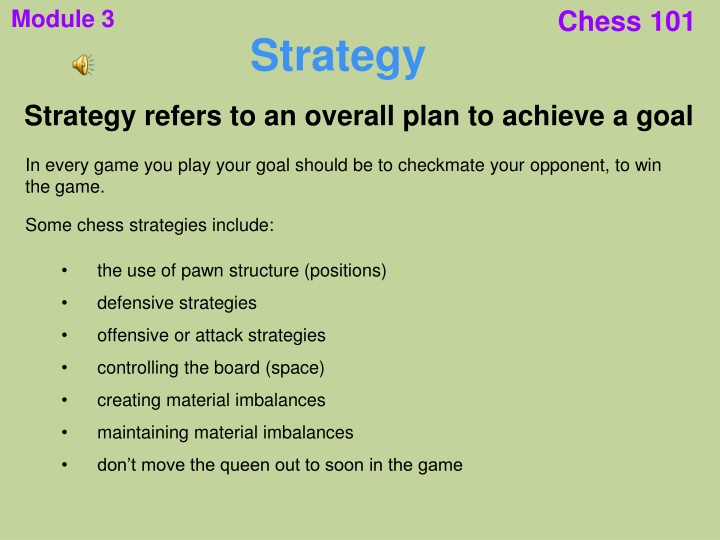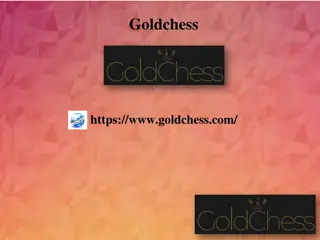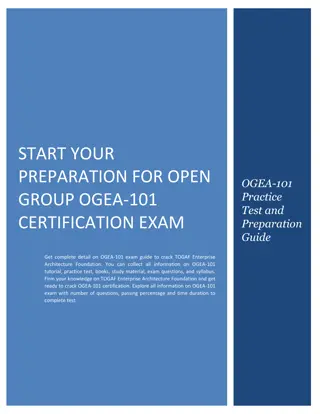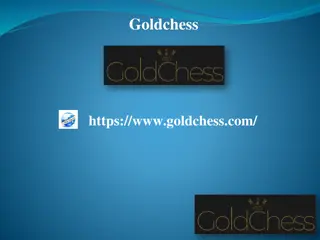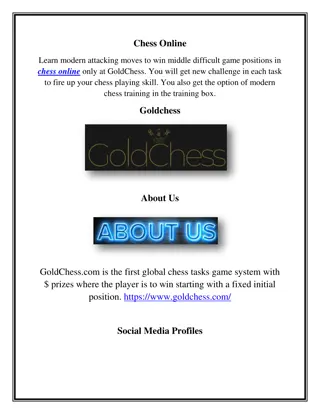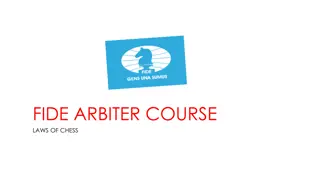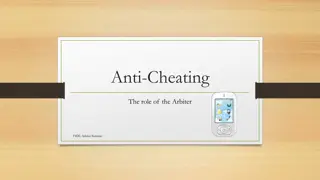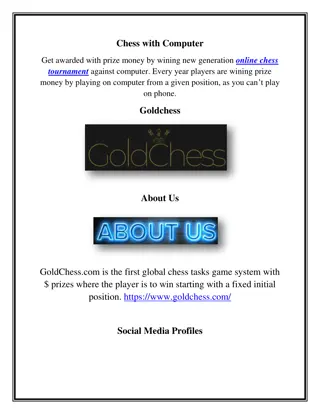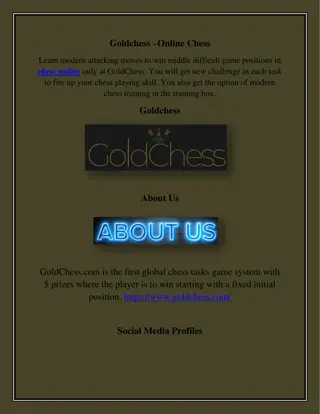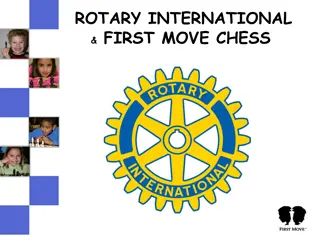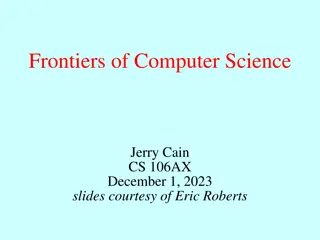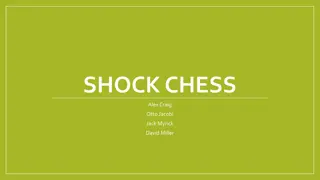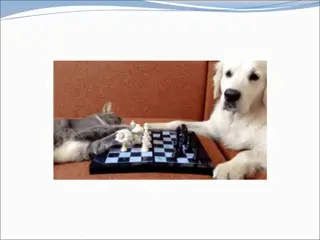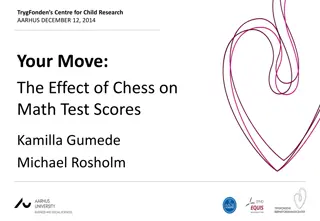Mastering Chess 101 Strategy: A Comprehensive Guide
Delve into the intricate world of chess strategy with this comprehensive guide focusing on key concepts such as controlling the center, pawn structures, and piece development. Learn valuable tactics to outmaneuver your opponent and achieve the ultimate goal of checkmating your way to victory.
Download Presentation

Please find below an Image/Link to download the presentation.
The content on the website is provided AS IS for your information and personal use only. It may not be sold, licensed, or shared on other websites without obtaining consent from the author.If you encounter any issues during the download, it is possible that the publisher has removed the file from their server.
You are allowed to download the files provided on this website for personal or commercial use, subject to the condition that they are used lawfully. All files are the property of their respective owners.
The content on the website is provided AS IS for your information and personal use only. It may not be sold, licensed, or shared on other websites without obtaining consent from the author.
E N D
Presentation Transcript
Module 3 Chess 101 Strategy Strategy refers to an overall plan to achieve a goal In every game you play your goal should be to checkmate your opponent, to win the game. Some chess strategies include: the use of pawn structure (positions) defensive strategies offensive or attack strategies controlling the board (space) creating material imbalances maintaining material imbalances don t move the queen out to soon in the game
Module 3 Chess 101 Strategy Controlling the center of the board - d4, d5, e4, e5 - pieces closer to the center tend to be more mobile/have more options Bishop at e5 (Be5) vs. Bishop at b2 (Bb2) - Be5 can move to 13 other squares - Bb2 can move to 7 other squares Nd5 vs. Na1 - 6 vs. 2 moves a knight on a rim is usually dim
Module 3 Chess 101 Strategy White would like to gain control of the center using his d & e pawns as would black. Black has a better opening due to his knights being active before his bishops If white were to move the bishops before the knights, there may be confusion as to where is best to move the bishops.
Module 3 Chess 101 Strategy White begins the game: 1. e4 Black opens with e5: 1. e4 e5 White continues: 1. e4 e5 2. Nf3 White begins to establish control of the central board while black counters and establishes equal control. White s second move develops the knight while attacking black s e-pawn.
Drill 3-1 Chess 101 Strategy 1. Moving a chess piece twice, or more, during the beginning of a game is ______ strategy. (good or bad) 2. It is _______ chess strategy to develop knights before bishops. (good or bad) 3. A good strategy in chess is to ________ develop your pieces exclusively on one side of the board. (definitely or not) 4. A good chess strategy is to ________ trade pieces in a way that develops another piece for your opponent. (definitely or not) 5. Trading a weaker piece of yours for a stronger opponent piece is ______ strategy. (good or bad) 6. Early attacks that result in no advantage is usually a _______ strategy. (good or bad)
3-1 Answers Chess 101 Strategy 1. Moving a chess piece twice, or more, during the beginning of a game is bad strategy. 2. It is good chess strategy to develop knights before bishops. 3. A good strategy in chess is to not develop your pieces exclusively on one side of the board. 4. A good chess strategy is to not trade pieces in a way that develops another piece for your opponent. 5. Trading a weaker piece of yours for a stronger opponent piece is good strategy. 6. Early attacks that result in no advantage is usually a bad strategy.
Create Your Own Chess 101 STRATEGY Here is where YOU become a teacher! Whoa, those last drill questions were a bit tricky. Time to do a little thinking about strategy. In just a few sentences, try to explain the truth behind each of the previous drill s questions and answers. Be creative, have fun show your teacher and the world what you can figure out about chess strategy.
Module 3 Chess 101 Strategy Material Advantage: the beginning of the end Material advantage refers to having a stronger army than your opponent and using this advantage to dominate and win the game. Relative point value of the pieces: pawns are each worth one point knights are each worth three points bishops are each worth three points rooks are each worth five points the queen is worth nine points the king is priceless! Things to remember for you ll learn them one way or another: a weaker army that is very well positioned can win the game as pawns near promotion they gain value in their potential to be promoted near the end of a game, with few pieces left, the king becomes an offensive weapon
Drill 3-2 Chess 101 Strategy 1. How many points is the black army worth? 2. How many points is the white army worth? 3. Its white s turn to move: with about 40 choices there are a few good choices and one that is the absolute best move to make. What is white s absolute best move to make? 4. Its black s turn to move: with about 20 choices there are a few good choices and one that is the absolute best move to make. What is black s absolute best move to make? THINGS TO THINK ABOUT This one position and the questions above can lead to some interesting theories of the game. How many theories (possible strategies or methods of thinking about every move in every game) can you come up with?
3-2 Answers Chess 101 Strategy 1. Black s army is worth 7 points: R = 5, each pawn = 1. 2. White s army is worth 15 points: Q = 9, B = 3, each pawn = 1. 3. White s absolute best move to make is: Qxg7++. 4. Black s absolute best move to make is: Rb1+, white can only delay defeat by blocking the check with the bishop at e1 which the rook takes for checkmate or with the queen at c1 which the rook takes followed by the bishop block. THINGS TO THINK ABOUT 1. When its your move look for a checkmate and take it (why do anything else?). 2. A well positioned army that is weaker can still win the game. 3. Mating nets (checks that force further checks that lead to mate) are worth finding. 4. A back door, an escape route, for the king in the endgame can save the game.
Module 3 Chess 101 Strategy Material Advantage Successful players know that losing pieces for no reason leads to defeat while the opposite is also true: capturing more of your enemy army creates an advantage in material that can lead to victory. Trading pieces of equal value throughout a game creates no material advantage. Trading lesser valued pieces for higher valued pieces creates material advantage. If a piece of yours is trapped, is going to be captured, it is often better to capture any enemy piece and die then just letting it be captured for free. The general who wins the battle makes many calculations before the battle is fought. The general who loses makes but few calculations beforehand. -Sun Tzu
Module 3 Chess 101 Strategy Material Advantage In chess material refers to soldiers in an army, the pieces, their number and strength. The masters have learned that each piece has different strengths and weaknesses and therefore, different values. The standard scale of piece power is: Pawn 1 point Knight 3 points If ignorant both of your enemy and yourself, you are certain to be in peril. - Sun Tzu Bishop 3+ points Rook 5 points Queen 9 points Note that the King has no point value for to lose it means defeat; yet, it often is an offensive weapon in the end game. Remember to always protect your King!
Drill 3-3 Chess 101 MATERIAL ADVANTAGE 1. What is the point value for a pawn? 2. What is the point value for a queen? 3. What is the point value for a knight? 4. What is the point value for a bishop? 5. What is the point value for a king? 6. What is the point value for a rook? 7. What is the point value for each army at the beginning of a game? (not including the king) 8. For the position at the right, what are the point value totals for each color? (not including the kings)
3-3 Answers Chess 101 MATERIAL ADVANTAGE 1. The point value for a pawn is one. 2. The point value for a queen is nine. 3. The point value for a knight is three. 4. The point value for a bishop is three. 5. The point value for a king is priceless or nothing. 6. The point value for a rook is five. 7. Each army starts with a point value of 39 not counting the king. 8. For the position at the right, the point value for white is 30 and black is 28. (not including the kings)
Create Your Own Chess 101 MATERIAL ADVANTAGE Here is where YOU become a teacher! Create, save, and turn in at least five questions and answers concerning material advantage. Make up a story, or two, about material advantage. Be creative, have fun show your teacher and the world what you know about material advantage!
Module 3 Chess 101 Chess Module Review The previous drills were for you to know the material in this module before being tested on it. You can always review the course material that you ve learned and you should do this if you miss ANY of the drill exercises. Play at least three games for practice or rating Submit notated games for grading
Test #4 Chess 101 Strategy 1. What does strategy refer to? 2. What is the ultimate strategy in chess? 3. Controlling the center of the board refers to what four squares on the board? Questions 4 - 14: True or False 4. Moving a chess piece twice or more during the opening game is good strategy. 5. Developing knights before bishops is bad strategy. 6. It is good strategy to develop your pieces on only one side of the board. 7. Trading pieces of even value in a way that develops an additional piece for you but not your opponent is good strategy. 8. Trading a stronger piece of yours for a weaker opponent s piece is good strategy. 9. Early attacks that result in no advantage is usually a bad strategy. 10.If it is your move and you are not in check, the best thing to do is see if you have a checkmate move to make against your opponent. 11.A well positioned army that is very weak compared to the opponent can still win the game. 12.It is usually good strategy to have a back door, an escape route, for your king. 13.Two rooks are worth more than a queen. 14.Two knights, or a bishop and a knight, are worth more than a queen.
Answers Chess 101 Strategy 1. Strategy refers to an overall plan to achieve a goal. 2. The ultimate strategy in chess is to win the game. 3. The squares d4, d5, e4 and e5. 4. False 5. False 6. False 7. True 8. False 9. True 10.True 11.True 12.True 13.True 14.False
Module 4 Chess 101 Tactics PIN MOVES A pin locks an enemy piece (defensively) where it is so it can t be moved. Black s bishop is pinning the white rook which can t be moved because its king would then be in check. Black s queen is pinned by the white rook. Since it will be captured its best move would be to capture the rook even though white s bishop would then take it.
Module 4 Chess 101 Tactics PIN MOVES White s queen is pinning black s rook and bishop. In this position black can not save both pinned pieces. Black can gain a material advantage by pinning the white queen with Bb4.
Module 4 Chess 101 Tactics PIN MOVES White pins the rook at d5 with 1. Bb2 Can you find the mating net if for black, if black were to move first? White is down in material but can pin and win the black rook with Bb2.
Drill 4-2 Chess 101 PIN MOVES 1. White to move and gain a material advantage. How can white do it? 2. How can black save the game? 3. How can black win a piece?
4-2 Answers Chess 101 PIN MOVES 1. Nxf5 NxN 2. Rf2 2. 1. QxQ+ 2. KxQ Bb7 3. 1. Qxe2+ 2. QxQ RxR Thus it is that in war the victorious strategist only seeks battle after the victory has been won, whereas he who is destined to defeat first fights and afterwards looks for victory. - Sun Tzu
Create Your Own Chess 101 PIN MOVES Here is where YOU become a teacher! Create, save, and turn in at least five questions and answers concerning pin moves. Make up a story, or two, about pin moves. Be creative, have fun show your teacher and the world what you know about pin moves!
TEST #6 CHESS 101 TACTICS: Pin 1. What move is black s to pin? 2. What move is black s pin? 3. What move is white s pin? 4. What move is black s pin? 5. What move is white s pin? 6. What move is black s pin? 7. What move is white s pin? 8. What move is white s pin?
#6 answers TACTICS: Pin CHESS 101 1. R x R 2. Bb7 3. Bb2 4. Rd8 5. B x N 6. Rd2 7. Bg5 8. Rc7
